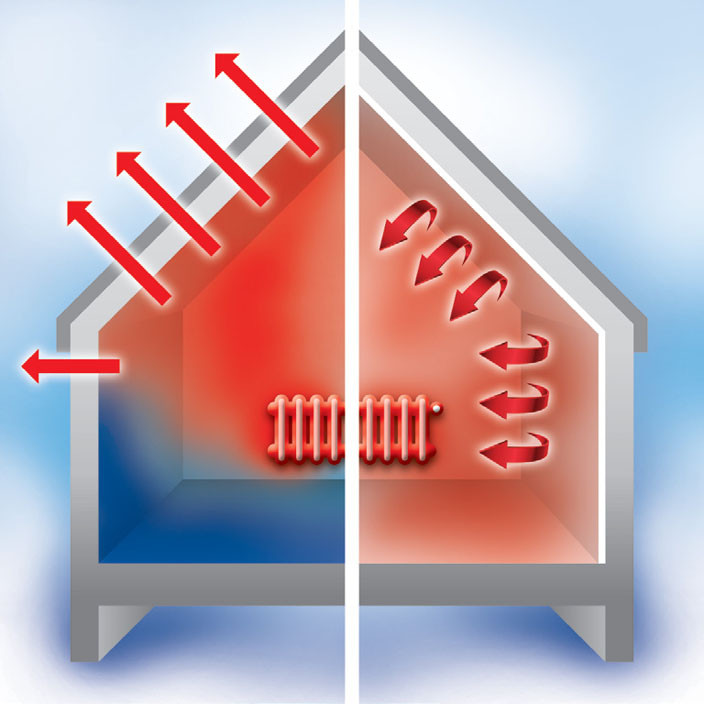Advantages of application

Advantages of application
KOFATERM coatings and pastes provide thermal insulation because of their reflective properties and result in cost-of-energy savings of up to 40%. It should be noted that each of these products works within a different range of electromagnetic waves, therefore, to ensure maximum efficiency it must be used in accordance with their intended purpose.
KOFATERM indoor
KOFATERM indoor
The first phenomenon pertains to the properties of building partitions, which, having specific thermal resistance, allow the energy of heat waves to penetrate their structure and to escape outside (heat always moves from places with a higher temperature to places with a lower temperature). In this way, we experience significant energy losses which can be seen in thermal imaging pictures.


In the first case, KOFATERM INDOOR coating acts on the wall like a mirror for thermal waves where the heat practically does not penetrate the partition (wall, ceiling) and is returned to the room at a 90% rate.
In the second case, KOFATERM INDOOR thermal waves reflected by the coating equalize the temperature across the room and exhibit temperature differences not to be exceeding 1-2°C (1.8-3.6°F).
In summary KOFATERM INDOOR products effectively eliminate the undesired effects of the aforementioned phenomena, allowing for 7°C (12.6°F) higher room temperature compared to a space outfitted with conventional forms of insulation while reducing the demand for higher-use energy which results in savings of up to 40%.

KOFATERM outdoor

KOFATERM outdoor
The first phenomenon occurs in hot climates or during hot seasons in temperate climates, where the external wall is heated by solar energy in the form of electromagnetic waves in the full spectrum of visible light including IR thermal waves. On a sunny day when the air temperature reaches 35°C (95°F) the surface temperature of the wall can reach as high as 60-70°C (140-156°F).
The second phenomenon mainly occurs in temperate climates where during rainy seasons the wall absorbs water from precipitation and the air. Moisture entering the partition is reducing its thermal resistance which increases the demand for thermal energy during the heating season leading to a significant increase in energy usage.

KOFATERM OUTDOOR coatings address both undesired phenomena described above. In the first example, thanks to the thermal reflection properties 90% of thermal radiation is reflected off wall surfaces, causing the wall to have a temperature only a few degrees higher than the air temperature. The previously mentioned external wall then has a surface temperature of less than 40°C (104°F), rather than 60-70°C (140-158°F), which means that the air conditioner will consume less energy.
In summary, KOFATERM OUTDOOR coatings not only operate in hot climates, providing energy savings of up to 40% but also protect and preserve the wall from the outside in temperate climates, resulting in significant savings during the heating season.
KOFATERM roof
KOFATERM roof
The first problem arises in hot climates or during hot seasons in temperate climates when the roof surface is subject to intense solar radiation, which arrives in the form of electromagnetic waves, including IR heat waves. A hot day with an air temperature of 35°C (95°F) causes the temperature of the roof surface to reach up to 80°C (176°F).

The accumulated thermal energy from the heated surface penetrates the roof and, in time, reaches the interior of the building. To lower the interior temperature the utilization of cooling equipment (air conditioner, fan) is required, and that increases the consumption of electrical energy. The lower the thermal resistance of the roof the more energy is needed to cool the room. Additionally, sun-exposed roof continuously heats up and stores thermal energy. As a result, even during evening hours when it is already cool outside, the thermal energy accumulated in the partition continues to heat the interior. The air conditioner works at high efficiency not only during the day, consuming large amounts of energy, but also in the evening and at night.
The second problem is the insulating materials used inside the roof partition, which when exposed to high temperatures over a long period lose thermal resistance, i.e. insulating efficiency. It should be noted here that many thermal insulation materials experience permanent degradation and irreversibly lose their insulating properties. The outcome is reduced thermal resistance of the roof, up to 50% of its initial value, and results in increased demand for energy needed for cooling in the summer and heating in the winter.
The energy demand needed for maintaining the desired temperature inside the structure is decreased which translates to up to a 40% of cost reduction.
Last, but not least, KOFATERM ROOF coatings eliminate micro-cracks on the roof surface and our paste perfectly seals it and enhances soundproofing.